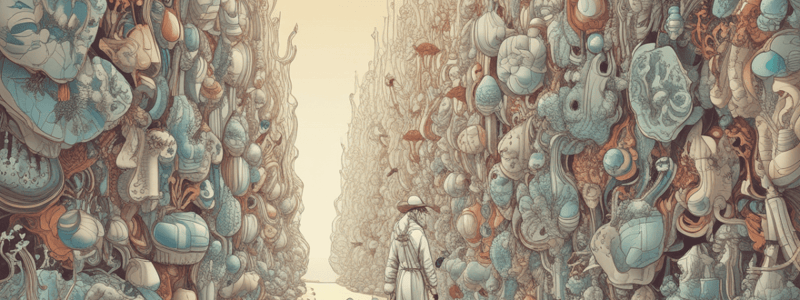Podcast
Questions and Answers
The study of the interactions between organisms and their environment is ______.
The study of the interactions between organisms and their environment is ______.
ecology
The jelly-like substance inside a cell is called ______.
The jelly-like substance inside a cell is called ______.
cytoplasm
The process by which plants produce energy is called ______.
The process by which plants produce energy is called ______.
photosynthesis
The ______ of a cell contains the genetic material (DNA).
The ______ of a cell contains the genetic material (DNA).
The study of the structure, behavior, and evolution of the universe is ______.
The study of the structure, behavior, and evolution of the universe is ______.
The study of the chemical processes in living organisms is ______.
The study of the chemical processes in living organisms is ______.
The process by which best-adapted individuals reproduce is called ______.
The process by which best-adapted individuals reproduce is called ______.
The chronological record of life on Earth is the ______ record.
The chronological record of life on Earth is the ______ record.
Flashcards are hidden until you start studying
Study Notes
Branches of Biology
- Botany: study of plants
- Zoology: study of animals
- Microbiology: study of microorganisms (bacteria, viruses, etc.)
- Ecology: study of interactions between organisms and their environment
- Biochemistry: study of chemical processes in living organisms
- Molecular Biology: study of biological molecules (DNA, proteins, etc.)
- Cellular Biology: study of cell structure, function, and behavior
- Evolutionary Biology: study of evolution of species
- Genetics: study of heredity and variation
- Biophysics: study of physical principles underlying biological processes
Cell Biology
- Cell structure:
- Plasma membrane: outermost layer of cell
- Cytoplasm: jelly-like substance inside cell
- Nucleus: contains genetic material (DNA)
- Mitochondria: energy-producing organelles
- Cell function:
- Metabolism: energy production and consumption
- Photosynthesis: process by which plants produce energy
- Cell signaling: communication between cells
Genetics
- Mendel's Laws:
- Law of Segregation: each trait is determined by two alleles
- Law of Independent Assortment: genes sort independently during reproduction
- Law of Dominance: dominant allele masks recessive allele
- DNA structure:
- Double helix: two complementary strands of nucleotides
- Nucleotides: building blocks of DNA (A, C, G, T)
- Gene expression:
- Transcription: DNA to RNA
- Translation: RNA to protein
Evolution
- Mechanisms of evolution:
- Natural selection: process by which best-adapted individuals reproduce
- Genetic drift: random change in gene frequency
- Gene flow: movement of genes between populations
- Mutation: change in DNA sequence
- Evidence for evolution:
- Fossil record: chronological record of life on Earth
- Comparative anatomy: similarities between different species
- Molecular biology: similarities between DNA and protein sequences
Branches of Biology
- Botany is the study of plants
- Zoology is the study of animals
- Microbiology is the study of microorganisms like bacteria and viruses
- Ecology is the study of interactions between organisms and their environment
- Biochemistry is the study of chemical processes in living organisms
- Molecular Biology examines biological molecules like DNA and proteins
- Cellular Biology explores cell structure, function, and behavior
- Evolutionary Biology explores the evolution of species
- Genetics studies heredity and variation
- Biophysics examines the physical principles underlying biological processes
Cell Biology
- The plasma membrane is the outermost layer of a cell
- Cytoplasm is the jelly-like substance inside a cell
- The nucleus contains genetic material (DNA)
- Mitochondria are energy-producing organelles
- Metabolism is energy production and consumption
- Photosynthesis is the process by which plants produce energy
- Cell signaling is communication between cells
Genetics
- Mendel's Law of Segregation states that each trait is determined by two alleles
- Mendel's Law of Independent Assortment states that genes sort independently during reproduction
- Mendel's Law of Dominance states that the dominant allele masks the recessive allele
- DNA is structured as a double helix with complementary strands of nucleotides
- Nucleotides are the building blocks of DNA (A, C, G, T)
- Transcription is the process of DNA to RNA
- Translation is the process of RNA to protein
Evolution
- Natural selection is the process by which best-adapted individuals reproduce
- Genetic drift is a random change in gene frequency
- Gene flow is the movement of genes between populations
- Mutation is a change in DNA sequence
- The fossil record is a chronological record of life on Earth
- Comparative anatomy shows similarities between different species
- Molecular biology shows similarities between DNA and protein sequences
Studying That Suits You
Use AI to generate personalized quizzes and flashcards to suit your learning preferences.




